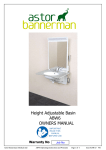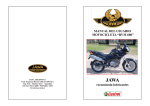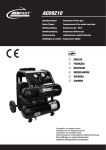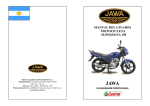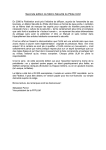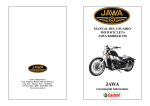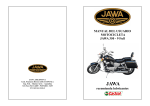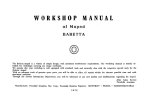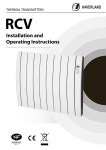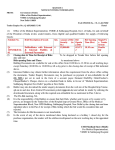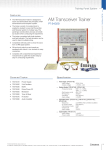Download July 2011 pt 1 - North American Jawa/CZ Register
Transcript
WANDERINGS INTERNATIONAL North American JAWA/CZ Register Newsletter July 2011 Phone (251)343-0726 Mike Thomason, Editor 1548 Deerwood Dr. E. Mobile, AL 36618 Contents: © North American JAWACZ Register Email: [email protected] Internet home page: www.JAWACZregister.org From the Editor This issue is a bit early because I want to remind you all that International JAWA/CZ/Yezdi Day is July 10. It will be the 9th annual event, which is observed all over the globe. The largest crowds are in India and Bolivia, but there are riders just about everywhere participating. For our newer members, and there are quite a few this year, the idea is that everyone with a JAWA, CZ or Yezdi (the Indian version of JAWA) gets out and rides, with others if possible or alone, if not. Take a picture and or write a brief account of your ride and send it to www.JAWAday.org where Vic Simmons will post it on that website. For many of us in North America there isn’t another JAWA or CZ nearby, but riding on JAWA/CZ/Yezdi Day you are a part of a virtual world-wide rally. Go to the JAWADay website and look at past JAWA days and you will see what I mean! Use your imagination, and your Czech motorcycle to help keep our favorite machines on the road where they belong. On October 1 Irvin Bittner will host the 6th annual “Gathering Under the Linden Tree” at his home in West Chicago, Illinois. This is a day of Czech bikes, food and beer, and meeting friends old and new who love Czech machines. It is hard to describe, but fun to experience! Irvin is helped by his son and their many Czech friends. People bring JAWAs and CZs so there may be thirty or more machines on display. There will be more about this day-long party in the September newsletter, but save the date and join us for this unique event. The weather in many parts of the continent is out of whack, or seems to be. We are in an extreme drought along the Gulf Coast, while the upper western states are flooding. We are too hot and it’s too cold in the north. Some parts of Canada are considering abolishing summer, I understand, while we have nothing else down here. So take your mind off the weather and ride your trusty JAWA or CZ. Get ready for JAWA/CZ/Yezdi Day! Letters Mike, I have some questions about my 1972 JAWA 350 Californian: I have had a very, very tough time getting my pistons up the cylinder or lower the cast iron cylinders onto the piston while keeping the rings compressed. The standard ring compressors do not work and it would be great if I had a simple sleeve. How do you guys manage this? I gave up trying few days ago! If you have time, here's the link with loads of pictures... http://s292.photobucket.com/albums/mm38/joel_jacob/1972%20JAWA%20350%20Californian/ I re-greased the wheel bearings and put new brake shoes for both wheels. However they don’t spin smooth. Is this normal with new shoes? Any suggestions would be appreciated! Cheers, Joel 505-603-6513 [email protected] Wanderings International July 2011 1 Joel, Over the years I've done it 3 ways. Sometimes I've been successful squeezing the rings by hand while lowering the cylinder over them. I've also used hose-clamps to compress the rings to slide the cylinder over them. Seems to me I also used a standard ring compressor to push the piston into the cylinder from the top sliding it through far enough to slide the wrist pin in with the rings still inside the cylinder. For the brake shoes, try loosening off the axle bolt and re-tighten it while holding the brake lever full on. Then reset the shoes. Bill English Joel: Re: Cylinder installation. I doubt a ring compressor exists; no conventional one that I have will work. The cylinder has a chamfer on the bottom that will allow you to assemble without a compressor. Check the end gap on your rings in the cylinder. I don’t have the spec offhand (.2mm), but it is likely in the book. If not, I’d file the rings for 0.01 - 0.15 mm. (.004 - .006”). Be careful as they are cast iron and brittle. My procedure is to oil everything well and then slide the cylinder down to the top ring. Use a small piece of wood (ice cream bar stick) to push the ring into the chamfer and eventually the groove as you apply downward pressure on the cylinder. Work around the circumference with the stick. Be sure the ring gap is centered on the dowel pin in the groove. Keep going until all the rings are in place. An alternative is to put the pistons in the cylinders and then install the pins. Heat the pistons with a heat gun to just over 212 degrees (spit fizzes) to allow the pins to slide in. NEVER use a hammer on engine parts. This might work better on a 250 single. I’ve tried it in the past and don’t care for it. Re: Brakes. The shoes have to be centered and even then may drag lightly when new. The lever goes against a shoulder on the cam. The lever nut should be tight without having any effect on the brakes dragging. If it does and the shoes don’t return fully against the flats on the cam, something is wrong/ bent/ burred/ dry in that assembly. Be sure to grease the cam bore and very lightly grease the cam faces and the sides of the shoes where they may rub on the backing plate. Put the wheel in the bike and tighten the brake as tight as you can while spinning the wheel as you tighten the wheel nut. This will center the backing plate and shoes. A slight drag is OK so long as the backing plate and drum don’t get hot while you are riding. The high spots on the shoes will soon wear off, and you may have to readjust the brakes after the first 50 miles or so. Don Kueny Joel, I use hose clamps to compress the rings. Adjust the tension just right and you can slide the cylinder over the piston and it will push the clamp down. Once the piston is safely in the cylinder remove the clamp by opening it up. This method is particularly useful because the rings are pinned to keep them from rotating on the piston. You can tell if the pins are in the ring gap because you can easily wiggle the clamp about a degree each way until the ring hits the pin. If it does this then you are ready to drop the cylinder over the piston. If the clamp does not move freely then a pin is not in the gap or the clamp is too tight. Jim Downey Thank you. All these suggestions are good and should work! I know you all speak with experience! I'll give it a fresh shot and let you know! The piston rings are brand new and any damage to piston, connecting rod or wrist pin is probably done by hammer already! I'll know when it/ if it fires up I guess?! I'll keep you all posted after my move to the new place. I wish I had asked before my adventures..! Joel Mike, The JAWA Klub Prague 1961 in The Czech Republic is celebrating its 50th year. We are trying to help raise some cash for the club by selling some special edition shirts, patches and hoodies. You can see them on the club page http://www.JAWAklub.cz/shop . I will calculate the shipping and send you some prices if you or some members of the Register are interested in purchasing some items. If you think that it is possible to put out the information on your page that would be great. I thank you in advance, Steve Clark [email protected] Wanderings International July 2011 2 Mike, I wanted to let the members of your club know that my hometown of Wilber, Nebraska is having it's 50th annual Czech Festival, starting August 5th and going through the weekend. It's a celebration of all things Czech and it would be great to see some JAWA /CZ bikes in the motorcycle show. I'd probably buy you dinner if you showed up on a Czech bike :) http://nebraskaczechsofwilber.com/schedule.html When I was young my parents used a couple of JAWA 175's on the farm, probably the 1st bike I rode on. Steve Ourecky email: [email protected] Hi: I hope you can help me? My husband recently purchased a 1977 350cc JAWA with side car. He is looking for the service manual downloads, and 'I've been looking for 4 days, and came upon your name. The numbers he was able to find are serial 633-5-000-911, motor 634-047-925 year 8/1977. Would you be able to help me? Tracey Winnipeg, Manitoba, Canada [email protected] Hi Michael, It is a small world after all! I was just thinking about returning your e-mail when my phone rang and Tracey's husband AJ called about the motorcycle. We will get together next week; they live just across the Assinaboine River maybe two miles from my house. AJ and Tracey are our age, retired and we have the same old motorcycle friends. This is probably a dream come true, to have someone interested in JAWA motorcycles living so close, thanks! Attila [email protected] This last exchange happened while I was working on this issue of the newsletter. It is typical of what goes on, and the helpful work of our members. Recently we helped three fellows who are restoring CZ-a and a CZ-t. One lives in Australia, the other in California, the third in North Carolina. All are now members of the Register and very happy to get help from members and the library. Please feel free to reply to Joel Jacob, Jim Clark or Steve Ourecky. I hope some one can go to Wilber Nebraska for their Czech festival. I imagine it will be fun. You will see the replies Joel has gotten within hours of his original email. That is typical of the members of the JAWA Register! Editor Letters from the UK Ian wrote the following last spring, but I didn’t have a place for it in the last newsletter. Now I do, and it will be followed by his early summer letter. I think that these are too good to not run them both! Editor Letter from the UK.(2) By: Ian Bridge After a very hard winter here in Britain it was a relief that March saw a vast improvement in the weather, and the chance to get out and do some riding. The month also saw me having to take my 650 JAWA (model 836) to a local motorcycle vehicle Wanderings International July 2011 3 testing station for its annual MOT (Ministry of Transport) examination and safety certificate, however prior to the actual test I noticed that the MITAS (Czech made) rear tire was approaching its minimum tread depth (in the UK, min depth of tread for motorcycles is 1mm or 0.040”). So it was off to my local specialist motorcycle tire factor, where a new Bridgestone version was fitted. The bike then easily passed its annual test. For my North American friends who may not be familiar with what a MOT test is, in Britain once a vehicle reaches the 3rd anniversary of its first registration, there is then a requirement for it to be tested by an approved testing station each year. Without the test certificate and also a valid certificate of Insurance it’s not possible to obtain a ‘Road Tax’ disk which entitles the vehicle to be used on public roads. Unfortunately there is a cost in doing this which is not inconsiderable. Sunday 27th March and the country has just altered its clocks from GMT (Greenwich Mean Time) to BST (British Summer Time), which means advancing the clocks one hour, so also one less hour in bed! I’m having my first cup of tea of the day when the telephone rings and a motorcycling work colleague asks if I want to accompany him on a ‘Breakfast’ ride to the beautiful Cotswold Village of Bourton-on-the-Water. Before my wife could say “No, I’ve got chores for you to do”, I’ve rolled the 650 JAWA out of my garage, and am on my way to meet him. Now Swindon, my home town, although a commercial and industrial centre, is very nicely situated in the northern part of the county of Wiltshire, which is primarily a rural county. It also lies just a few miles south of the Cotswolds, an area of outstanding beauty with its world famous small idyllic villages, and Bourton-onthe Water is one such village about 30 miles north. So at 09.15 I meet up with my friend and although the temperature is chilly at 6 deg C (43 deg F), I’m well wrapped up and have the heated Handlebar grips (a real luxury on cold days) on to keep me warm. We head out of Swindon with me taking the lead, and with the big 650cc JAWA motor spinning freely, we head off towards Cirencester [known as the capital of the Cotswolds – see www.the-cotswolds.org ] on the main north bound duel carriageway, and with the speedo indicating just below 70 mph we are quickly past Cirencester and onto the normal ‘A’ class road. Our speed drops back to a sedate 50 mph as we head deeper into the beautiful countryside, and with less traffic the ride becomes even more leisurely and enjoyable. We arrive at Bourton-on-the-Water at just before 10.00, park up and walk over to an adjacent café, only to find it not open. Seems the owners were caught out or forgot to adjust their clocks. We walk along the village main area (which also has a picturesque river flowing through it), to another café which was open, and where we had a good traditional English breakfast and more lashings of hot tea. With the sun poking its head out and the air temperature starting to rise, after leaving the café we strolled back along the main village street with all its small shops, sat for a while on a park bench to watch the loads of other motorcyclists who were now out, some even on old British machines – really good. It was then time to head back home as I was under strict instructions to be back for the Sunday lunch my wife was preparing. So once again with the big JAWA fired up, we headed back, but this time primarily using small unclassified roads. I love these roads as usually they are narrow lanes, mostly totally traffic free and frequently go through small hamlets that you would not normally see. By riding mostly on main roads these hidden gems of places usually go totally unnoticed, and like so many things in life, by always taking the fastest most direct route you don’t always fully appreciate the beauty and serenity of your own countryside. Our journey took us through many of these small and beautiful hamlets, (where I just wished I was rich enough to be able to afford to live;) back towards the small village of Bibury (www.bibury.com) and past ‘Arlington Row’, a row of weavers cottages built of local stone next to the River Coln. The buildings have been used as film sets for many ‘Period Piece’ cinema and television dramas. Then, it was off traveling south again, this time towards the village of Fairford. Fairford has a huge RAF base next to it, which until early last year was also used as a USAF air base. Apparently due to its extra long runway it is also still classed as an emergency runway for the US space shuttles. Past the base and into the village of Kempsford, before the final short leg back to Swindon and a nice Sunday Lunch. Wanderings International July 2011 4 This type of ride is what I really enjoy. Visiting beautiful places, meeting fellow motorcyclists, and enjoying the chance to ride one of my JAWA motorcycles. Roll on the next JAWA ride. Letter from the UK (3). By:theIan Bridge Well, here in the UK with better weather, the JAWA/CZ JAWA Owners Club events and activities have started now that Spring has arrived. April saw the opening weekend camp in the village of Pewsey, which is in the south of England near to the famous town of Marlborough, and was attended by over 30 people. The Saturday saw a run-out to the near-by town of Calne where there was a small motor museum. We were blessed with exceptionally good weather and it was nice that the UK JAWA importer (F2 Motorcycles) proprietor – David Angel came along. The Easter weekend saw the running of the International Classic Motorcycle Show in the Midlands town of Stafford. The International Classic Motorcycle Show is probably the largest event of its type in the world and is very much a traditional classic show that attracts the best from around the world. There are club stands, trade stands, private entries and a massive autojumble that fills several of the halls and outside field at the Stafford County Showground. It is always a great draw for the enthusiast and last year over 30,000 people flocked to the showground. Bonham’s Auctioneers & Valuers always run a classic auction on Sunday, with this year a single wheeled PAV 41 motorcycle trailer going for £1,200. (approx $1,800). And to think I sold one in better condition a few years ago for £150 ($220)!!! The Owners Club has for at least the past 25 years put on a Club display at this show, and despite the huge mass of other Classic machinery, the UK Club display did this year pick up three awards. Roger Henderson got a 3rd placed prize with his 1934 350cc SV JAWA. Our National Newsletter Editor – John Woods won best original machine at the show with a 1980 Jawette moped (showing you don’t need a super machine to win), and member Mick Wainwright won a highly commended rosette with his beautiful 1955 CZ Walter Road racer. May saw a group from our Hampshire area holding a weekend get together. Unfortunately they were plagued by poor weather, but despite a smaller turn-out possibly due to the weather, those that attended did enjoy themselves. The weekend of July 1st – 3rd sees the UK Clubs premier event of the year, our National Rally and AGM. This year the event is being held at a Rugby Football Club in the town of Chorley, which is in the north of England. This event usually attracts well in excess of 100 JAWA and CZ owners, so it’s always good to see a great variety of models. The Club in Great Britain was formed way back in 1954, so 2011 see’s our 57th anniversary year. For any organization to last that long continuously is certainly an achievement, but for that organization to be a ‘OneMake’ Motorcycle Club representing owners of machines from an East European country is surely unique. So what’s so special about the Club that has seen it survive through what has been a turbulent historical period, and one of great change for motorcycling? Firstly I believe it has been due to the dedication of a small number of members, who even when times were bad, soldiered on to keep the Club going. The same applies to you guys in North America who are fortunate in having a few really dedicated people to Wanderings International July 2011 5 keep everything together for your group. You have the added problem of covering a far bigger land area with fewer members, but it is really important that you don’t just be armchair members, but do contribute and take part. There is nothing more demoralizing than for events to be run and a magazine produced, for there to be a lack of support. Secondly, of course it’s the bikes themselves. With basically what has been a minority marque in Britain, the Owners Club has attracted owners, due to the help, advice and support it has been able to offer. Thirdly, there’s been the support of like-minded people, and in many ways this has created the feeling of belonging to a very special select family. Of course there are many other reasons why people initially decide to join, but I’m sure one of the reasons they stay, is due to the good friendships that are made. I very much doubt that the founding members of the UK Club way back in 1954 could ever have envisaged that the results of their efforts would still be available today for all to see. Since the collapse of the Communist empire, JAWA production has dropped to an extremely small scale compared with their hay-day of the 1970’s, and of course they have the added issue of competing with new oriental area emerging markets. We can all just hope that unlike the demise of the once mighty British Motorcycle Industries to the Japanese onslaught that JAWA does not go the same way. What is certain is that the Czechs have a wealth of engineering skills and a strong will to succeed. If any people can, they will. JAWA Club Ireland Newsletters The JAWA Club in the Irish Republic is a lively group. Below are the Tables of Contents of their last newsletters. Use the internet addresses provided and see for yourself! Issue 11 Advertisement / Beer Drinking Bikers / Clogheen / Cheap Flights / Donation / Editors Note / Events / JAWA Ireland / JAWA CZ Yezdi Day / JAWA on Show / JAWA on the BIG SCREEN / LIE DETECTOR / Links / SPROCKET / What a Beauty / Wanted / Your Comments http://www.JAWAcz.com/issue11.html Issue 12 Topics covered include: Advertisment / April Sales / Beer Drinking Bikers / Club Links / Chicken Song / Crack in My Windshield! / Financial Independence / Editors Note / Events / JAWA CZ Posters / Mike’s Photos / MORNING RIDE - JAWA STYLE / Clogheen 2011 Report / Photos From Clogheen 2011 / Small End Rebuild / The Swim to Clogheen / Your Comments p://www.JAWAcz.com/issue12.html Wanderings International July 2011 6 JAWADay 2011 in New York State This year we will have the annual vintage ride and hope some JAWAs can come too! The ride is on JAWADay July 10. Meet at 11 am in Woodstock, NY lodge off RT 375. There is no charge to participate in the 40 mile ride which will end at a restaurant, as usual. “Eat to ride-ride to eat” is our motto. For more information contact Ed Allyn [email protected] The Moto Giro (shown above) is the first weekend (for small bikes over 40 years old) of May every year in the upstate New York / Mass area. Other places also include California and Italy where it started first. Now here for good! The JAWA Californian belongs to Ed Allyn. The owner of the Cezeta is not known. CZ-t Restoration in North Carolina I am getting close on parts, but I really need the rear fender and stays. Keep your eyes open. I looked at the eBay CZ, and it’s exactly what I have, although mine is in 1000 pieces and primered, it is a.1949 CZ 125T. Engine is polished and together. I have new pipes and mufflers, as well as cables, bellows, etc. Allan Cleaver has my speedo and is having someone redo it. My seat is not original either. I also have picked up quite a few books and brochures, and will be happy to add to your collection. Mike Cole [email protected] Mike’s project is one of three early CZ restorations currently underway. Remember that these machines are over sixty years old! Editor Wanderings International July 2011 7 As found.... Right now I am going to be focusing on rebuilding the motor. I have it completely apart and cleaned, but I need to figure out what gaskets and bearings I need. The San Diego CZ-a So far a few other members have emailed me. I must say I am truly thrilled at meeting other enthusiasts! This is such a great community. I can't wait to see mine come to life. I will follow up with the contacts you have provided as well. I can promise you now mine will be road worthy in its purest form soon. I quite like the green color though, so that may stay. I imagine someone waaaay back when thought that color would work nicely. I think I may even be the second owner. I have the original title. Wild!. Thanks for the attachments as well. You've got an abundance of great resources here. I also wanted to share my website with you. I will be documenting the process pretty thoroughly. http://almostbohemian.com/1947cz/ Thank you once again. I can't say that enough. I am happy to join this club and offer support in any way I can! Also, if it hasn't yet been done, I can upload my manual copies once I get them and make it a nice little PDF. That may be helpful in the future. Let me know if I can help in any way! David Kulacz [email protected] Wanderings International July 2011 8 The Jawetta Moped Jawetta was introduced in 1958 although it was just referred to as the JAWA Moped at first, the Jawetta name appearing slightly later in literature and adverts. This, like the more well known Pionyr ultra lightweight motorcycle before it, was designed by the JAWA factory in Týnec near Prague. But unlike the Pionyr, the Jawetta was also manufactured in the main JAWA factory in Týnec. The Pionyr was manufactured, from the first “Tree Stump” model in 1955, by a company called Považské Strojárne in the northern Slovak town of Považská Bystrica. This makes the Jawetta the only true JAWA moped since all subsequent mopeds that were sold as JAWAs, such as the Babettas, the model 05 & 20 scooters and the Mustangs were all also made in the Považské Strojárne factory alongside the JAWA 90s and Manet scooters. At 49.8cc it was the smallest capacity bike that JAWA ever produced. The Jawetta was only produced for four years ceasing production in 1962. In that time it was sold across Eastern Europe and to several western European countries and the USA but not in Britain. I have literature from Finland and from Holland showing that they were sold there as well as from the USA where the leaflet above comes from. In 1961 a standard model Jawetta in the USA would have cost you $175, which is £62.50 at that time. By comparison, at about the same time a CZ175 would have cost you about £140. The Jawetta was sold alongside the Pionyr with the Jawetta being advertised as “more suitable for women and juveniles” with the Jawetta being a bit cheaper than the Pionyr. The main competition, in Eastern Europe at least, would have been from another Czech moped manufacturer, Stadion, with its S11 moped, another model which never made it to Britain. The original Stadion was a more conventional “bicycle with an engine” type of moped and used a very similar engine that was made for them by JAWA. Many of the engine parts are common to both the Jawetta and Stadion as well as some other components. Various Stadion models sold until 1966, and later models copied a variation on the Jawetta’s monocoque type frame construction as well as using forks and headlamp nacelle which appear to be identical to the Jawetta’s. The Jawetta has a number of interesting and unusual features. Probably most notable is that there is no frame as-such but the moped is of monocoque construction with the main structural part being formed from two symmetrical pressings of 0.8mm (0.032”) sheet steel welded together longitudinally in a central rib running the length of the moped and extending to form the rear mudguard. This forms partly semi-closed and partly fully closed hollow sections reinforced with several stays. Although this makes a very rigid but light structure for the frame, the down side is that it makes working on the moped very difficult. Normal service items, plug, points, magneto clutch etc are fairly accessible but you need very thin hands and long fingers to be able to unscrew the down-draught carburetor top or reach the throttle cable adjuster for instance. The slow running screw and the main jet are accessible with a screwdriver through a small hole in the right hand side of the bodywork and the carb tickler is accessed by a finger through a similar hole in the other side of the frame. The air cleaner sits inside an enclosed section above the engine and requires the carb to be removed first to be able to remove it. The 3 liter fuel tank sits inside the front section of the frame and slides up from the bottom towards the steering head. It is not possible to remove the tank without removing the engine first. Removing the engine is a difficult job in itself, since the rear suspension and the centre stand are both Wanderings International July 2011 9 fixed to the engine and have to be removed and replaced with it. The rear wheel is not hard mounted as it might appear but there is a pivoting fork supported in bushes in an extension on the rear of the engine. The bushes are lubricated automatically by the gearbox oil. The upper end of the rear fork fastens to a single large spring located inside the frame under the seat. The front suspension is by a pair of pivoted bottom links with springs located inside the bottom section of the “U” shaped pressed steel fork legs. Both front & rear springs have rubber inserts acting as progressive bump stops. The moped has two gears, cable operated by a left hand twist grip using components identical to those used for the throttle on the 250 & 350 JAWAs of the period. The centre position is neutral with first being engaged by twisting the grip away from the rider and second towards the rider. The clutch lever, which turns with the twist grip, has a tongue that engages into three slots machined in the handlebar, holding the gear engaged against spring pressure from the cable. First gear is barely needed when starting on the flat but gives the moped good hill climbing ability. TECHNICAL DATA Engine – two stroke, air cooled, single cylinder Capacity – 49.8cc Bore – 38 mm Stroke – 44 mm Compression ratio – 1:7.5 Power – 1.5 hp at 4,750 rpm Engine lubrication – mix oil in petrol – 1:25 Fuel consumption at 30 km/hr – 1.65lt / 100km Fuel tank capacity – 3 lt Machine weight – 42 kg Maximum load - 220 lbs (100 kgs) Maximum speed on level ground - 28 mph (45km/h) Primary drive – helical tooth gear Secondary drive – chain 12.7 x 4.8 100 links Overall gear ratio – 1st gear – 1:27.90 2nd gear – 1:13.88 Suspension, front – leading link, 62 mm travel rear – swing arm, pivoted in engine block, coil spring in frame under seat, 58 mm travel Wheels – 23” x 2” Tires – 23” x 2.00” MY JAWETTA I bought my moped from Slovakia earlier this year and it is probably the only Jawetta in the UK as they were never imported here. It was manufactured in 1960 and had done only 905 kilometers in its 51 years - so not even run-in yet! I was contacted by e-mail, through my web site www.JAWAmoped.com by a Slovakian lady named Andrea Panikova living in Ireland. She sent a few pictures and asked if I knew of anybody who might be interested in buying it. It seems that an uncle of hers bought the Jawetta from new and only used it a couple of times before hanging it up in his workshop for the next 40 years. On the gentleman’s death it passed to, Andrea’s father, Vojtech Panik, who also ran it a bit and then put it into storage. I had a brief discussion about the moped with my wife, but decided to go ahead and buy it anyway! A price was agreed and money transferred. The moped was in the town of Okres Piešťany about an hour’s drive from Bratislava in the Slovak Republic. After a failed attempt to get a UK bike transport “specialist” to collect the moped, Andrea found a local, small delivery company who were capable of doing the job. The company, VAN-2-3, make regular trips between the Czech and Slovak Republics and the UK in a van delivering and collecting bikes and mopeds. Dominik Kasubjak who I dealt with, speaks perfect English and was very helpful and efficient. There was a couple of weeks’ wait until his next scheduled trip over here when he collected the moped from Wanderings International July 2011 10 the seller and transported it all the way to my doorstep in North Wales and all for a very reasonable charge – cash on delivery. I would thoroughly recommend VAN-2-3 and they are prepared to find particular models for you in CZ, SK, or Poland and deliver them over here. I might be contacting him again myself when Janine has forgotten how much I have spent on this one. Contact VAN-2-3 at www.van23.com e-mail [email protected] phone +421 907 260 321. The moped is completely original except for the seat having been replaced by a later Babetta one as the original one was eaten by mice while the moped was in storage. It is still fitted with the original spark plug from 1960 and the original tires – I expect that even the air in the tires is original. Vojtech was kind enough to send me a leather “flying helmet” which was bought by the original owner at the same time as the moped suitable protective headgear in 1960. The moped has no registration as this was not required for mopeds in 1960 Czechoslovakia. The moped seems to have been looked after quite well, there is no real damage evident just a few scratches in the paint – notably on the front mudguard and there seems to have been some sort of a problem with the wiring, with evidence of a short circuit at some time. One or two small rubber parts had deteriorated – rubber buttons for the steering lock stops and the seal in the fuel filler cap. The only rust evident is on the spokes and one patch of missing chrome on the front rim. This cleaned up all right after a scrub with a wet Brillo pad – a tip, originally from Mario, for cleaning up pitted chrome. I have stripped it down in order to give it a thorough clean and remove all the dust and a little bit of road muck/grease around the engine and to be able to more easily service everything. I T-Cut all the paintwork, de-greased the outside of the engine and went over all the plated steel parts with a small, fine wire brush. All the cables - and there are 7 of them - were lubricated inside and cleaned outside with WD-40. The best thing I have found to clean rubber and plastic parts is Swarfega and a tooth brush then wash in soapy water. It has been re-assembled exactly as original. All the original nuts, bolts and washers have gone back where they came from. One missing screw was replaced with a correct type from one of my coffee jars of fixings removed from other JAWA-CZs – NEVER throw anything away! I managed to find a new replacement seat to exactly the original design, luckily the seat is the same one as used on the less rare Stadion S11. That came from Slovakia along with the one or two other small parts that had to be replaced. The wiring damage was repaired retaining the original wire and terminals and all the original wiring and sleeving re- used. I cleaned & set the points and the plug, replaced the gearbox oil and then fired her up – second kick! She runs beautifully, as you would expect from a 905 km from new bike. My first chance to ride it was round the car park at the Stafford show. I expected it to be a little awkward to ride with the hand gear change and a rear brake that is applied by pedaling backwards but it is no problem. Starting on flat tarmac from stationary barely requires first gear and I expect would be quite possible in second once I’m used to the short travel clutch lever. In first gear she carried me surprisingly easily up the rather steep vehicle ramp to the upper level of the show hall. I’ve now got a dating letter from Arthur Fleming and once insured and MoT’d I’ll apply for registration although I am unlikely to use it much on the road. John Woods, Torque Editor Mike, We have just returned from the UKs largest Classic Show - held this year over Easter. It attracts about 40 thousand people over 2 days. The Club had 12 bikes. http://www.classicbikeshows.com/gallery/list.asp John Woods "new to him" 1960 JAWA moped (Slovakian import) won Best Original Bike, Roger Henderson’s 1934 350 was 3rd Post Vintage and Mick Wainwright’s CZ Walter racer was highly commended. We really put it over on the Brit bike, Italian and other Clubs!. Pete Edwards Wanderings International July 2011 11 John Woods award-winning 1960 Jawetta moped as it stands today Swindon Smoke Signals on the Subject of Small Engined JAWAs It was really interesting to see on the recent cover of Torque 4/2011, our National Club magazine editor John Woods’ very rare 1960 Jawetta which he had imported from the Czech Republic Now John with this machine (he also hosts the excellent JAWA Moped web site. www.jawamoped.com ) was the winner of the ‘Most Original Machine’ at this year’s International Classic Motorcycle Show which took place in April. Compared with the hundreds of other ‘Classic’ machines at this show this was indeed a great result for John and also for the Owners Club, and showed that you didn’t need a ‘mega-priced’ classic to win an award. John’s success with this machine took me back to my own adventure way back in 1993 when I took part along with 1500 other motorcyclists in the annual 500 mile ACU National Navigational Rally, on the smallest capacity machine in the event - a 50cc JAWA Jazz moped. For those who might be interested I reproduce the report I wrote way back then of my trials and tribulations. 1993 ACU/BMF/CSMA National Navigational Rally This year’s rally was to be held over the weekend of 3rd/4th July, with the finish being at the East of England Show ground Peterborough. For those of you unfamiliar with this event, it basically operates as follows: (a) There are some 55 checkpoints scattered around the country, and within a set mileage, you have to try and plot a route which enables you to visit as many as possible. (b) Certain of the checkpoints are only open until 10 pm. (c) You can have up to a maximum of 20 hours to complete the event. (d) There are Wanderings International July 2011 12 statutory rest periods. There are four classes of awards: Special Gold [500 accredited miles plus maximum possible number of checkpoints]. Gold [495/500 accredited miles plus a lesser number of checkpoints] Silver [395/494 miles]. Bronze [250/394 miles]. There are other rules as well but I won't go into them now. Having already done the event six times on my 350cc JAWAs, this year I decided to try and make it more of a challenge for myself, and also possibly get a bit more publicity for the Club and the Marque. As most machines that take part are large capacity ones, I thought that a good stunt would be to do it on the smallest capacity machine. So at the International Motorcycle Show at Birmingham last November, I approached JAWA/CZ General Manager in this country Josif Chytil with the proposition of borrowing one of their JAWA Mopeds. Joe agreed, and so when the entry forms were sent out early in March my entry quickly went back as doing the event on a JAWA Moped. Following further correspondence, the JAWA Jazz moped was eventually delivered to Mike Coombes' Crowmarsh Classic Bikes workshop. My wife took me to Mike's, and after picking it up I rode it home. The moped was a JAWA Jazz, 2 speed automatic - brand new (with only 115 Km on the clock), but the good people at Kings Lynn had carried out certain "go faster" modifications. I'm not sure exactly what they were, but the machine was fitted with a larger, forward facing carb, higher gearing, expansion chamber exhaust system etc, and while not fast by motorcycle standards, was easily capable of going at 45 mph. During the following week I rode the moped whenever I could, and although it went well, the spark plugs showed that it was running on the rich side. I contacted Kings Lynn, but it did seem that there was nothing I Ian Bridge ready for the 1993 Rally could do with respect to altering the carb's settings. Having chosen a route, I made up some route cards and made a small route card holder to fit on the handlebars, and together with a pair of borrowed cycle panniers to carry a few spares and food/drinks I was ready for the off. Saturday July 3rd was a warm day with a good forecast for the whole of the event – I breathed a sigh of relief at this, as last year’s event was run in atrocious weather conditions and with no Swindon checkpoint this year, the nearest ones were either at Abingdon or Andoversford near Cheltenham. I chose Andoversford, so with a 30 mile run to just get to the start point, I left at 12.15pm so as to arrive in plenty of time for the 2pm start. The ride to the start was uneventful, with the moped running well; however at Fossebridge on the A429 to Northleach there is a 14% steep hill. The moped got half way up it, but with my weight on it, there was insufficient power to actually get right to the top. I did in fact have to get off, and for a short period walk by the side of it. At Andoversford I met John Kennedy who had arrived just before me on his 1957 Lambretta 150cc scooter, we both fuelled up, had a drink and talked to other entrants who were interested in what we were doing the event on. The 2pm start saw a lot of riders leaving the checkpoint, and both John and I headed into Cheltenham on route to the first checkpoint at Tewksebury. I actually arrived at the first checkpoint before John, but on leaving, the moped started to cough and splutter and was reluctant to rev. John was off and away on his scooter, while I slowly managed to build up speed. As soon as the moped got to about 25mph it seemed to clear and started to run again all right. Up through Worcester and onto Kidderminster the moped ran reasonably all right, although while at the Worcester checkpoint I Wanderings International July 2011 13 decided to change the spark plug. Once again the one I took out was very black indicating rich running. The ride to Wem was accompanied by occasional miss- firing, but this I traced to the plug cap not sitting properly on the plug. With it on properly it again seemed to improve. The 25 mile run from Wem to Stoke-on-Trent was in fact the worst of the whole event, with me thinking that I might even have had to give up the event. From Wem to Market Drayton the bike was finding it difficult to get above 10 mph due to the fact that it didn’t want to rev, and sounded very sick indeed. From Market Drayton to Stoke the engine seemed to lack all power, and would not even pull up even the slightest of slopes. What should have taken me about an hour, actually ended up taking me nearly two. This loss of time was to put me behind the silver schedule I was working to, and I was never to make the time up. Feeling very frustrated now; at the Stoke checkpoint I stripped the carb’ down, changed the spark plug again, and generally fiddled with the carb’ settings trying to improve the running. I also noticed that the K & N type air filter used was oil-saturated and also clogged with hundreds of small insects. I cleaned this with the garage air- line at the checkpoint, but also decided to run without the filter to see if that also made an improvement. Well! The improvement was so dramatic that the little moped was now flying, and a steady 40mph was achieved easily. The road from Stoke to Ashbourne was a very enjoyable ride, although there was a 16% hill at one point which again meant I had a short walk by the side of the bike. However at Ashbourne as I was heading towards the Darley Moor Checkpoint, I saw John Kennedy coming the other way. We both stopped, had a quick chat, and were soon both on our ways again. My journey then took me up through Matlock, Chesterfield, Ollerton, Nottingham, Leicester, Melton Mobray, Bourne etc. Much of this part of the course was covered during the night session, and with the headlight on the moped not being very good, even though the bike was now running perfectly, I could not keep up a speed which would have enabled me to make up time. At about 5am on the Sunday morning while at Bourne, I made the decision that the chances of getting a silver were now touch and go, and as I was feeling tired, I decided to miss out 3 checkpoints and head for the Peterborough finish. I eventually arrived at Peterborough at 6.30am having covered 352 miles, but actually only being accredited with 315 and 14 checkpoints (Must have been the number of times I got lost!!). There were already about two dozen riders there, many stretched out on the grass having a nap, but of those awake there was immense interest that I had undertaken the event on such a small machine. Checking out time was officially from 7.30am although they did in fact actually open up at about 7.15am; I collected my award, then went to the cafeteria for a full cooked breakfast. I stayed at Peterborough till 8.40am, seeing Roland and Gordon Webb both arriving, together with Colin Gregory who arrived just as I was leaving. A photographer from Motor Cycle News took my picture with the moped, although whether they used it I don’t know. The 115 mile trip home, including a stop for coffee and toast at a Little Chef took me 4 hours, which all considering was really quite respectable for a moped. Our local newspaper The Evening Advertiser; also carried pictures of me and the moped on two occasions (one actually in color), and from the response I’ve had from work colleagues and family, all seemed suitable impressed. After all, at the end of the day it’s all been good publicity. From leaving home to arriving back home, I actually covered 490 miles in just over 24 hours, really quite respectable for such a small bike. I would like to especially thank Joe Chytil of JAWA for letting me borrow the bike; Barry Goodison from JAWA for arranging for the bike to be prepared and delivered to Mike Coombes, the fitters who prepared it and Mike Coombes for agreeing that the bike could be delivered and collected from his workshop. A good event with superb weather – roll on next year, when I believe the format is to change slightly. Ian Bridge Swindon Smoke Signals Newsletter #2 And you thought you have had adventures! Editor Wanderings International July 2011 14














